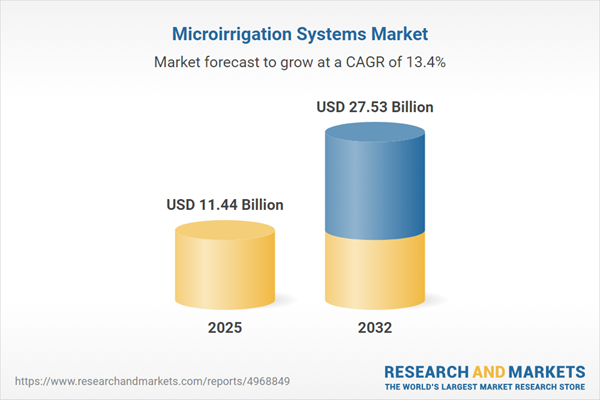Speak directly to the analyst to clarify any post sales queries you may have.
Microirrigation systems provide organizations with advanced tools for precise water management, helping senior decision-makers address critical operational, regulatory, and sustainability challenges while maintaining business agility.
Market Snapshot: Microirrigation Systems Market Size & Growth
The global microirrigation systems market reached USD 10.09 billion in 2024 and is forecast to reach USD 11.44 billion by 2025. Further expansion is expected, with projections anticipating the market to attain USD 27.53 billion by 2032, corresponding to a 13.36% CAGR. This upward trend is attributed to a rising focus on optimizing agricultural yields and water usage. Organizations are increasingly prioritizing solutions that ensure compliance and adaptability across varied regulatory and climate landscapes, driving heightened demand for efficient microirrigation systems.
Scope & Segmentation: Microirrigation Systems Landscape
- Crop Types: Microirrigation supports a diverse array of crops, including fruits, vegetables, vineyards, turf, specialty plants, and broadacre varieties. This versatility is vital for both intensive horticulture and scalable farming operations.
- System Types: The market offers several options such as bubbler, drip, micro spray, and subsurface drip systems. These technologies integrate seamlessly with both new and existing infrastructure, enabling organizations to respond flexibly to growth or retrofitting demands.
- Components: Key system components include digital controllers, emitters, pressure regulators, filtration units, pipes, fittings, and valves. These elements deliver durability and precise control, essential for operational upgrades or new installations.
- Applications: Microirrigation solutions address the needs of broadacre farming, landscaping, nursery operations, and greenhouses, allowing consistent, controlled irrigation for food production and green spaces in various settings.
- End Users: Stakeholders such as commercial growers, landscape managers, sports and golf facilities, greenhouse operators, and residential developers utilize these systems to maximize resource efficiency and manage operational costs.
- Distribution Channels: Organizations access products through direct procurement, distributor partnerships, and digital commerce, ensuring timely availability and alignment with evolving procurement strategies.
- Installation Types: Both retrofit and new installation formats empower decision-makers to quickly adapt infrastructure as operational priorities or compliance requirements change.
- Regions: Demand is evident across the Americas, Europe, Middle East, Africa, and Asia-Pacific. Notably, accelerated adoption is seen in China, India, and Japan, where technological investment and regulatory changes influence sector development.
- Companies Analyzed: Industry-leading providers include Antelco Pty Ltd., Hunter Industries, Irritec S.p.A., Lindsay Corporation, Netafim, Rain Bird, The Toro Company, Chinadrip Irrigation, DripWorks Inc., and Jain Irrigation Systems, each offering comprehensive portfolios for agricultural and landscape applications.
Key Takeaways: Strategic Advantages of Microirrigation Systems
- Sensor-based digital controls make it possible to adjust water delivery in real time, optimizing system performance for organizations managing multi-location or large-scale operations.
- Modular emitters and high-quality filtration components shorten transition times between crop cycles and facilitate rapid reconfiguration, supporting year-round productivity goals.
- Centralized, cloud-based monitoring tools enhance visibility over distributed assets, making data-driven management and reporting more accessible across portfolios.
- Integrating microirrigation systems streamlines adherence to sustainability programs and regulatory requirements, simplifying processes for periodic reviews and reporting obligations.
- Fostering regional supplier relationships serves as a buffer against market shifts or logistical disruptions, strengthening organizational resilience within volatile supply chains.
- Consistent access to technical training upskills teams, improves infrastructure investment outcomes, and upholds operational standards over time.
Tariff Impact: Navigating Policy and Supply Chain Shifts
Recent tariff adjustments in the US have influenced the cost landscape for microirrigation system components. Organizations mitigate these changes by enhancing their partnerships with regional suppliers and revising procurement models, which helps maintain supply chain integrity and consistent equipment performance despite evolving regulatory or logistical conditions.
Methodology & Data Sources
This analysis draws on detailed secondary research, direct interviews with sector leaders, and verification through independently reputable sources. The methodological approach is tailored to provide procurement executives, technical operations leads, and strategic planners with actionable guidance relevant to current and future water infrastructure projects.
Why This Report Matters: Outcome-Driven Benefits
- Detailed segmentation and technology profiling equip senior leaders to refine investment and operational decisions to match emerging industry needs.
- Integrated benchmarking tools facilitate accurate comparisons across suppliers and system solutions, resulting in more effective procurement and operational strategies.
- Expert insights guide organizations through regulatory changes, ensuring continued adaptability and sector competitiveness as the market evolves.
Conclusion
Investment in microirrigation systems equips organizations to manage resources effectively, protect operational continuity, and align with rising sustainability and compliance expectations in both established and emerging markets.
Additional Product Information:
- Purchase of this report includes 1 year online access with quarterly updates.
- This report can be updated on request. Please contact our Customer Experience team using the Ask a Question widget on our website.
Table of Contents
3. Executive Summary
4. Market Overview
7. Cumulative Impact of Artificial Intelligence 2025
Companies Mentioned
The companies profiled in this Microirrigation Systems market report include:- Antelco Pty Ltd.
- Hunter Industries, Inc.
- Irritec S.p.A.
- Lindsay Corporation
- Netafim Limited
- Rain Bird Corporation
- The Toro Company
- Chinadrip Irrigation Equipment Co., Ltd
- DripWorks Inc.
- Jain Irrigation Systems Limited
Table Information
| Report Attribute | Details |
|---|---|
| No. of Pages | 187 |
| Published | November 2025 |
| Forecast Period | 2025 - 2032 |
| Estimated Market Value ( USD | $ 11.44 Billion |
| Forecasted Market Value ( USD | $ 27.53 Billion |
| Compound Annual Growth Rate | 13.3% |
| Regions Covered | Global |
| No. of Companies Mentioned | 11 |









